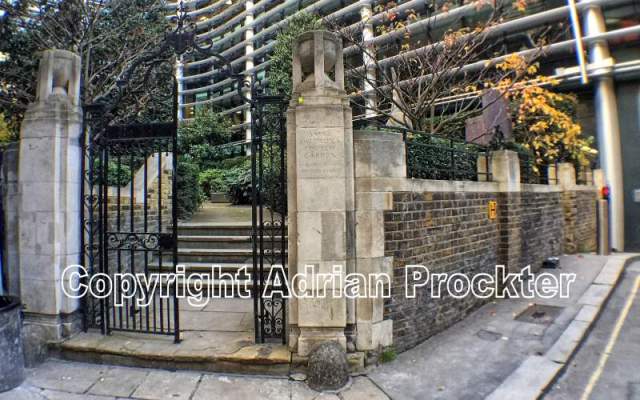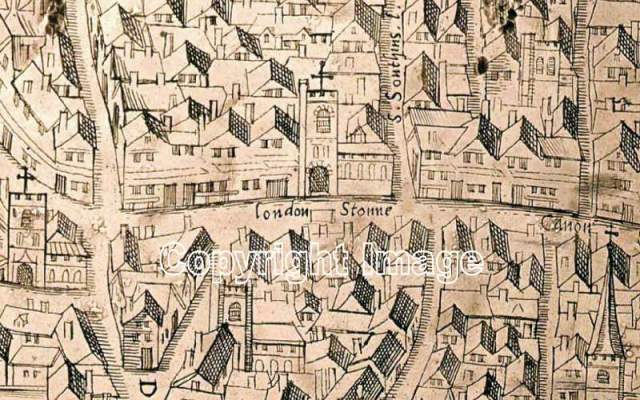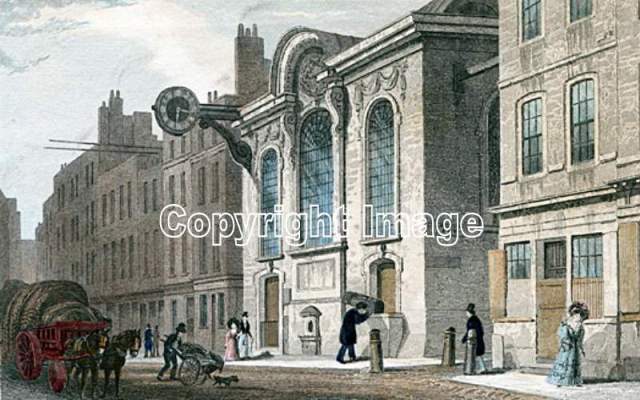Above: The original churchyard of St Swithin is situated at the northern end of Salter’s Hall Court.
St Swithin – that’s an unusual dedication to find for a London church. In fact its the only one by that name in the City of London. Swithin (often also spelt Swithun) lived in Saxon times and died in or around AD 862. He became Anglo-Saxon Bishop of Winchester. He is better known for the tradition that the weather on his feast day (15 July) will continue for 40 days.
A parish church bearing his name used to stand on the north side of Cannon Street – at the junction with St Swithin’s Lane – between St Swithin’s Lane and Salters’ Hall Court. The is believed to have been in existence by 1000 but its earliest recorded mention was in 1236. The church was destroyed in the Great Fire (1666) and later rebuilt 1677-85 by Christopher Wren. That church was to remain standing until the Second World War when it was badly damaged by bombing. The remains were eventually taken down and the site was cleared in 1962. Nothing remains to be seen of the church today, not even a City Plaque. At the northern end of Salters’ Hall Court is the churchyard, now in use as a garden.
Above: A small part of one of the Copper Plates. St Swithin’s church is clear to see with ‘London Stonne’ in the middle of Cannon Street.
So, what about the additional name of ‘London Stone’? How did that come about? The London Stone was a large piece of Clipsham Limestone, a good-quality stone from Rutland often brought to London for building purposes in both the Roman and medieval periods. Quite what the chunk of stone was originally used for is not known for certain. It is believed that it was used in Roman times as a sort of milestone from which distances to other Roman towns were measured. A blog has already been written about London Stone (see 1 June 2016) and many more details can be found there.
Above: Part of Horwood’s map (1799) showing the church of St Swithin at the centre of the map, beside St Swithin’s Lane. The little churchyard (labelled ‘Ch Yd’) is just above and to the left.
The first reference to the ‘London Stone’ was made about 1100 when it was near the middle of the roadway in Cannon Street (then called Candlewick Street). It is shown on one of the Copper Plate map sections (made about 1550) and it is also to be seen on the so-called Agas map (made about 1561). By 1720 what was left of the stone was protected by a small stone cupola built over it. In 1742 it had become a traffic hazard and it was moved, still within its protective cupola, to the north side of the street against the wall of the new Wren church of St Swithin. Two further moves, in 1798 and in the 1820s, placed it eventually where it was to remain for more than 100 years – built into the middle of the church’s south wall.
Above: A print by Thomas Hosmer Shepherd in the 1850s showing the north side of Cannon Street with the church of St Swithin and its large overhanging clock. Notice the London Stone (between the two doors of the church).
The Wren church was gutted by bombing in the Second World War, but the walls were left standing and London Stone remained in place until 1960, when it was moved to the then Guildhall Museum (at that time housed in the Royal Exchange) for safekeeping. After the demolition of the church ruins and the completion of a new building a few yards to the east – originally called the Bank of China – in October 1962, the Stone was placed in a specially constructed grilled and glazed alcove in the wall. It occupied that position until about 2015. Because the 1960s building was being demolished ahead of new offices on the same site, the stone was carefully removed to the Museum of London where it is currently on show until the new offices are completed. The stone can be moved back to its rightful position in Cannon Street once more.
-ENDS-





WOW
LikeLike